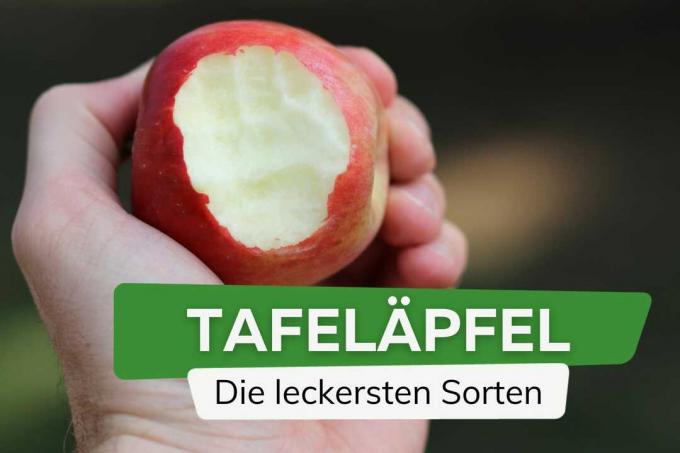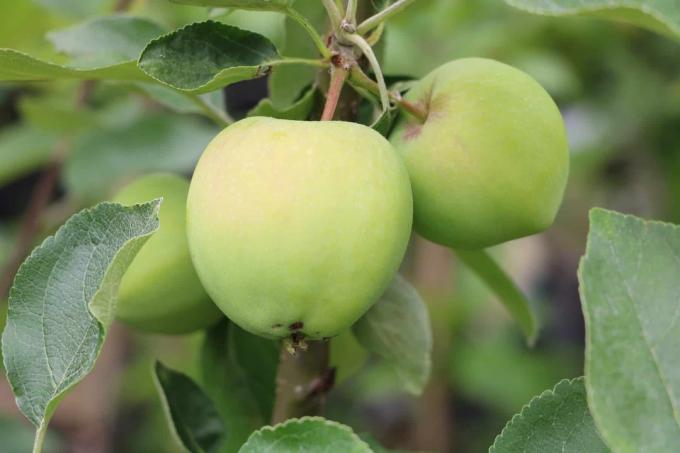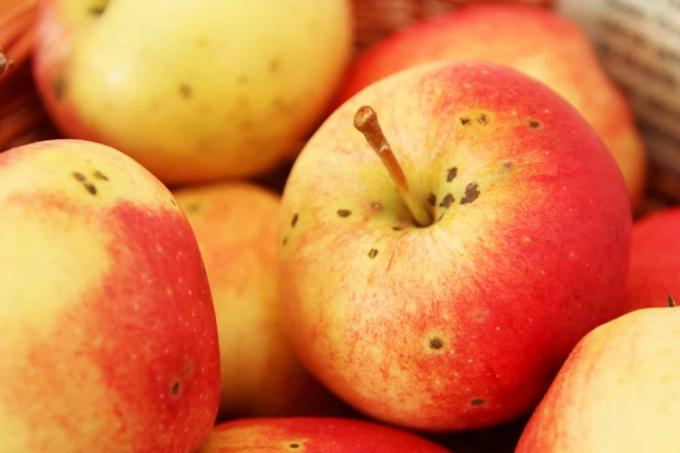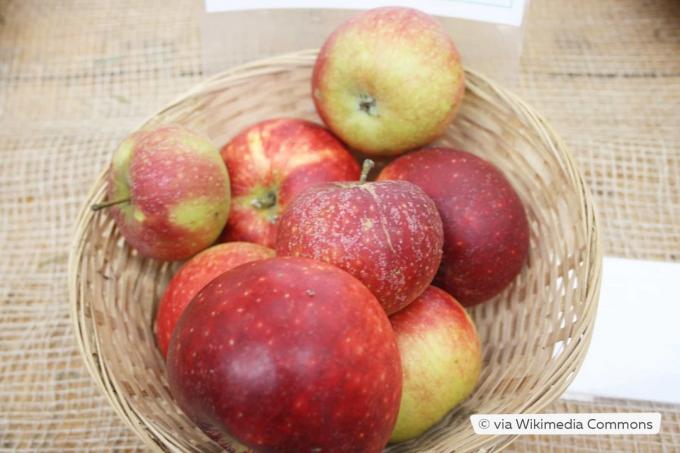
Pick an apple fresh from the tree and immediately bite into the crunchy, juicy-sweet fruit - that's pure pleasure! Here we present delicious dessert apples that you can use to bring this treat into your garden.
In a nutshell
- are suitable for fresh consumption directly from the tree
- are also versatile in the kitchen (eg. B. for baking, roasting or for cakes and desserts).
- Harvest the summer apples in July or August, but little or no shelf life
- Harvest the autumn apples between September and October
- Winter apples have the best storage potential
Table of contents
- What are dessert apples?
- 1. summer apples
- 2. autumn apples
- 3. winter apples
- frequently asked Questions
What are dessert apples?
Table apples are apple varietiesthat are suitable for consumption fresh from the tree as well for baking, cooking or juicing. In contrast to the sour cider apples, the fruits can be used in many different ways. Many dessert apples are also excellent storage apples, especially the late-ripening varieties such as
'Elstar', 'Boskoop' or count 'Ontario'. Depending on the variety, table apples ripen from summer until late autumn. We present the best varieties to you here.1. summer apples

Some apple varieties already ripen in the summer months. They taste best fresh from the tree, but cannot be stored. These are the most popular dessert apples in summer:
| apple variety | harvest time | durability | Color | The taste | fruit size |
|---|---|---|---|---|---|
| auguster | August to September | for fresh consumption, not storable | striped green and red | wine sour | medium-sized |
| clear apple | July | only for fresh enjoyment, not storable | light green to yellowish green | fresh and sour, but quickly becomes mealy | medium-sized |
| Nola | early August to early September | for fresh consumption, not storable | Red Yellow | sour-juicy | medium-sized |
| Piros | late July to August | for fresh consumption, can be kept for a maximum of three weeks | reddened when ripe | sweet and sour | medium-sized |

A notice: The variety, also known as 'white clear apple', is considered to be particularly robust and well suited for hillsides and harsh climates. In addition, the clear apple is ideal as a pollen donor.
2. autumn apples
However, most apple varieties ripen in the autumn months. They are usually easy to store and in numerous varieties of sweet until acidic available. The following table apples are particularly popular in autumn:
'Alcmene'

- Harvest time: early to mid-September
- Shelf life: until November
- Colour: yellowish skin, reddened on the sunny side
- Flavor: delicately sour
- Fruit size: small to medium-sized
Tip: The 'Alkmene' variety is rather small in size compared to other apple varieties and is therefore well suited for small gardens.
'Cox Orange'

- Harvest time: early September to mid-October
- Shelf life: until March
- Colour: green-yellow, bright red on the sunny side
- Taste: sweet
- Fruit size: medium
A notice: With its fine, sweet aroma and long shelf life, this variety is one of the best dessert apples there is. It is also a very old variety that can be used as a pollen donor for many other apple varieties.
'Elstar'

- Harvest time: late September to October
- Shelf life: until the end of January
- Colour: yellow skin, reddened on the sunny side
- Taste: sweet and sour
- Fruit size: medium
A notice: This variety is also a good and versatile pollen donor, and the trees are extremely productive.
'gala'

- Harvest time: mid-September to mid-October
- Shelf life: until February
- Color: red yellow
- Taste: sweet
- Fruit size: small to medium-sized
'Privy Councilor Dr. Oldenburg'

- Harvest time: September
- Shelf life: until December
- Colour: yellow-red, strongly reddened on the sunny side
- Taste: sour-juicy
- Fruit size: medium
Tip: This old apple variety is particularly suitable for the production of juice and cider, and it can also be used for baking and roasting.
'Gravensteiner'

- Harvest time: mid-August to mid-September
- Shelf life: until December
- Colour: yellow shell with red flames
- Taste: sweet-sour, juicy
- Fruit size: large
'Holsteiner Cox'

- Harvest time: mid-September to October
- Shelf life: until December
- Colour: greenish-yellow, red on the sunny side
- Taste: sour
- Fruit size: medium-sized, very high-yielding variety
'Ingrid Marie'

- Harvest time: mid-September to late September
- Shelf life: until March
- Red color
- Taste: sweet and sour
- Fruit size: medium
'rubinola'

- Harvest time: mid-September
- Shelf life: until February
- Colour: sweet and sour
- Taste: sweet
- Fruit size: medium
A notice: The 'Rubinola' variety is very robust and has good scab resistance.
'Santa'

- Harvest time: September
- Shelf life: until December
- Colour: bright red skin
- Taste: slightly acidic and juicy, similar to Elstar
- Fruit size: medium to large
Tip: 'Santana' is considered to be very well tolerated by allergy sufferers, and the variety is also insensitive to scab.
3. winter apples

As the name suggests, winter apples are harvested very late in the year. They can be stored very well and are versatile. However, winter apples are less suitable for fresh consumption: they should only be approx. stored for two months before they develop their full aroma. These dessert apples include:
| apple variety | harvest time | durability | Color | The taste | fruit size |
|---|---|---|---|---|---|
| boskoop | Mid-October to November, ripe for consumption from January | until April | greenish yellow or red | acidic | large |
| Braeburn | October | until February | red striped | sweet and sour | large |
| gold parmesan | Mid-September to mid-October, ripe for consumption from November | until February | yellow skin with bold red stripes | Spicy-sweet, crumbly if stored for a long time | medium-sized |
| Golden Delicious | late September to late October | until mid March | yellow-green | sweet and juicy | medium to large |
| Idared | Mid-October, ripe for consumption from February | until April | yellowish, reddening when ripe | finely sour | medium to large |
| ontario | from the end of October, ripe for consumption from January | until April | yellowish, reddened on the sunny side | mildly aromatic | large to very large |
| pilot | from the end of September, ripe for consumption from November | till May | greenish with vermilion streaks | sweet and sour | medium-sized |
| topaz | Late September to early October | until February | orange-yellow, reddening when ripe | sweet and sour, juicy | medium-sized |
| Winter bell apple | from October, ready to eat from January | until April | yellow peel with varying degrees of redness | fresh, sour, juicy | medium to large |

Tip: The old variety, also known as "Schöner aus Boskoop", is ideal for applesauce or compote, for cakes or baked apples for Christmas.
frequently asked Questions
The shelf life of dessert apples depends on the harvest time: The earlier a variety ripens, the shorter its shelf life. Summer apples should only be kept for a few days and eaten as fresh as possible, while classic winter apples should last until March or April if they are stored in an airy place.
"An apple a day keeps the doctor away" goes the old English proverb. According to the recommendation of the German Society for Nutrition (DGE), every person should have 5 portions (1 portion = one handful) of fruit and vegetables per day, of which two servings of fruit and three servings of vegetables omitted. So one or two apples a day is healthy.
On the contrary: Enjoying an apple in the evening even helps you fall asleep due to the pectin it contains! In addition, such an apple fills you up very well and helps you to lose or maintain weight - as long as you choose a variety with a low fructose content. Only people with a sensitive stomach Those who are prone to heartburn should avoid the evening apple: otherwise the fruit acid it contains will not allow the digestive tract to rest.
